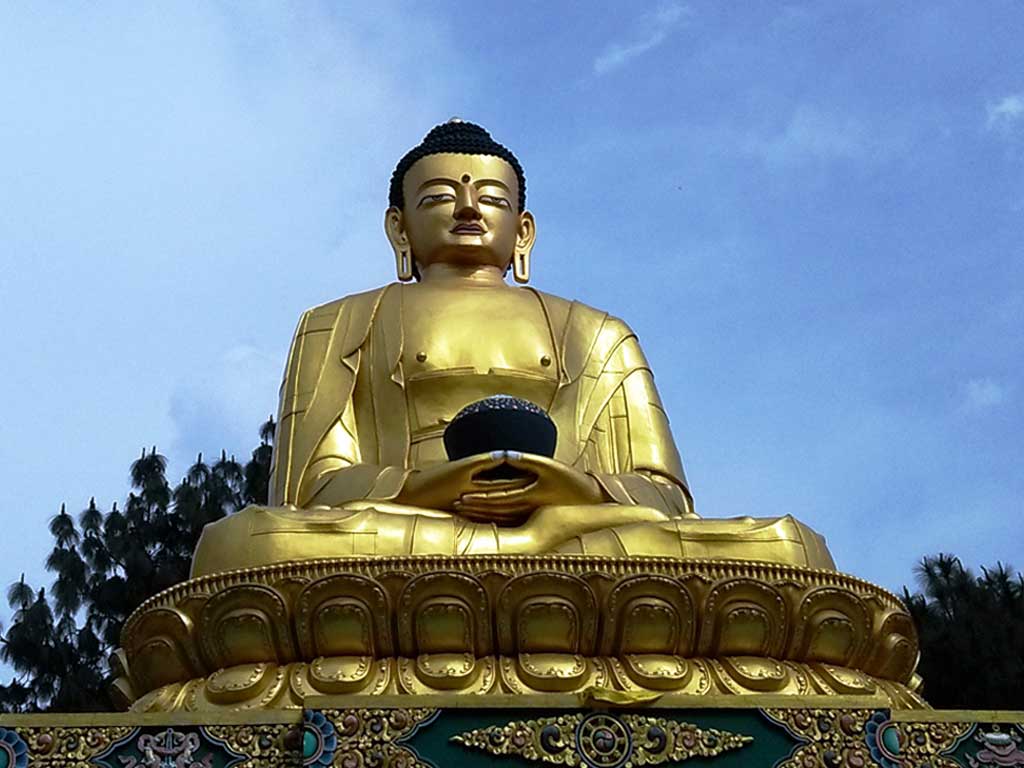Buddha was born in Nepal

One of the biggest Statute of Buddha (67ft / 20.4m) at Buddha Park near Swayambunath Stupa of Kathmandu
Buddha was born in Nepal, although every now and then, we all stumble into articles over the internet (and other sources) and find information printed about the birthplace of Buddha saying he was born in India. And for those who are still holding that false information about him— here is the story of Siddhartha Gautam who attained enlightened and become Buddha.
“Health is the greatest gift, contentment the greatest wealth, faithfulness the best relationship.”
Around 2580 years ago, in the small kingdom of Kapilvastu, a light of wisdom was born to King Suddhodhan and Queen Maya Devi who spent twenty-nine years of luxurious royal life and left the palace in quest of answers to questions of human suffering, and later meditates under Bodhi tree where he get enlightened with divine knowledge to become Buddha.
Buddha birth name “Siddhartha” was given by sage called “Asit” which means “one who has accomplished a goal” according to Sanskrit. Buddha was born in Kapilvastu Lumbini in present day Nepal; then got enlightened in Bodh Gaya of India and died in Kushinagar at the age of 80.
Prince Siddhartha was born
Prince Siddhartha Gautam was born to King Suddhodhan and Queen Maya Devi at Lumbini in 563 BCE. Born in the Khastriya “warrior” family, his childhood and adolescence time was full of luxury and recreation. He enjoyed all his royal upbringing and participates in military training as part of the tradition as he was supposed to be the future king. However, despite inheriting the father’s kingdom, Siddhartha left the comfort of the royal palace, his wife “Yasodhara” and son “Rahul” to seek the answers of piled sadness of human suffering caused by sickness, old-age and death and also to comprehend the life-cycle with human suffering and its end for perpetual happiness.
Siddhartha became Buddha
At the age of 29, Siddhartha left the palace for the answers, travel across many parts of India, meet great scholars and teachers, learn and evolved for next six years and arrived at Bodh Gaya where he decides to rest and meditate under Bodhi Tree until he finds ultimate answers he was seeking. After continuous meditation for several days, Siddhartha was enlightened with the light of the knowledge of all-pervading self-awareness and became Buddha.
After attaining divine knowledge of the universe, he spends next forty-five years of his life traveling throughout Indian sub-continent teaching his wisdom and preaching the path to self-realization and joyful happy life. All times are good times for happiness in life cycles which will eventually cause the suffering and grows as the greed and ignorance start to breed within. There should be no suffering.
"There is happiness in life, happiness in friendship, the happiness of a family, happiness in a healthy body and mind, ...but when one loses them, there is suffering."
To end the suffering there is a path to nirvana— the path towards an everlasting state of great peace and joy — which can only be known by learning the noble truth and achieved by following the noble path (also known as Middle Way).
Buddhist Chanting
“Om Mane Padme Hum” — “Om” is the sacred syllable in Hinduism and Buddhism, “Mani” means jewels, “Padme” means “Sacred Lotus Flower” and “Hum” means the spirit of enlightening.
Om Ma Ni Pad Me Hum — also represents six syllables for the purification of realm of Samsaric existence signifying the six paramita of Generosity, Ethics, Patience, Diligence, Renunciation, and Wisdom
“Three Jewels to Enlightenment”
“Buddham Saranam Gachhami” (I go to the Buddha for refuge)
“Dhammam Saranam Gachhami” (I go to the Dharma for refuge)
“Sangham Saranam Gachhami” (I go to the Sangha for refuge)
*Buddha is the guide, Dharma is the path and Sangha is the teachers/ companions.
“Every morning we are born again. What we do today is what matters most.”

Lumbini — Birthplace of Buddha
Lumbini was listed at UNESCO World Heritage Site in 1997 as “Birth Place of Buddha” as testified by the inscription graved on the pillar erected by Emperor Asoka in 249 BC, and several later discovered at 1896. Lumbini is one of the holiest places of Nepal and attracts thousands of travelers and pilgrims every year. Bordered by large monastic zone covered with monasteries of all branches of Buddhism — Lumbini has there are several temples, museum, monuments in the area of Lumbini including famous sacred Mayadevi Temple, Eternity Flame of Peace, sacred Bodhi Tree, ancient Asoka Pillar and Holy Pond “Pusakarini” where Buddha took his first bath after birth.
Buddhism around the world
Although there have been several sects introduced since the foundation of Buddhism, so far it has been categorized into three dominant branches — Theravada, Mahayana and Vajrayana Buddhism — along with several other individual schools manifested and developed under these dominant branch with their own practices and code of conduct and widely followed across the world — majorly in Asian countries like Nepal, Sri Lanka, India, China, Japan, Malaysia, Korea, Cambodia, Indonesia, Philippines, Myanmar, Singapore, Vietnam, Thailand, Taiwan with growing popularity in Europe and Americas.
Related Post
- Visit Nepal 2024
- Political Stability is a must for Nature conservation:
- What is Kathmandu?
- About Prayers Flag
- How did a Pothead Shiva come to be a Hindu God?
- Nepal World Heritage Site - Lumbini
- 9 Must See Places in Nepal
- Kumari - Mystic Living Goddess of Nepal
- National Heroes of Nepal
- Celebration of Sagarmatha Day
- Did you felt it? — Two Years after the Earthquake
- Who are Gurkhas? What is Kukri?
- Prince Harry Speech for Gurkhas
- Namaste
- Welcome to Archaic Nepal
Recent Post
- Visit Nepal 2024
- Shrawan Sankranti
- Must Try Off the Beaten Trekking Routes of Nepal
- Political Stability is a must for Nature conservation:
- Combating High Altitude Sickness
- Climate Change and the Himalayas
- What is Kathmandu?
- 13 Necessary Equipment for Peak Climbing in Nepal
- About Prayers Flag
- How did a Pothead Shiva come to be a Hindu God?








